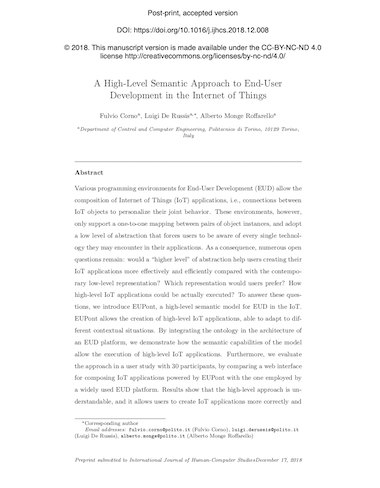Various programming environments for End-User Development (like IFTTT) allow the composition of Internet of Things (IoT) applications, i.e., connections between IoT objects to personalize their joint behavior. These environments, however, only support a one-to-one mapping between pairs of object instances, and adopt a low level of abstraction that forces people to be aware of every single technology they may encounter in their applications. As a consequence, some open questions remain: would a "higher level" of abstraction help users creating their IoT applications more effectively and efficiently compared with the contemporary low-level representation? Which representation would users prefer? How such high-level IoT applications could be actually executed?
The paper A High-Level Semantic Approach to End-User Development in the Internet of Things, to appear in the International Journal of Human Computer Studies, answers the previous questions by introducing EUPont, a high-level semantic model for EUD in the IoT.
EUPont allows the creation of high-level IoT applications, able to adapt to different contextual situations. By integrating the ontology in the architecture of an EUD platform, the paper demonstrates how the semantic capabilities of the model allow the execution of high-level IoT applications. Furthermore, the approach was evaluated in a user study with 30 participants, by comparing a web interface for composing IoT applications powered by EUPont with the one employed by a widely used EUD platform. Results show that the high-level approach is understandable, and it allows users to create IoT applications more correctly and quickly than contemporary solutions.
More information:
- A brief description of EUPont
- Paper on ScienceDirect (Elsevier)
- Paper on PORTO@IRIS, our institutional repository
- DOI: 10.1016/j.ijhcs.2018.12.008
- PDF of the accepted manuscript (post-print version)


